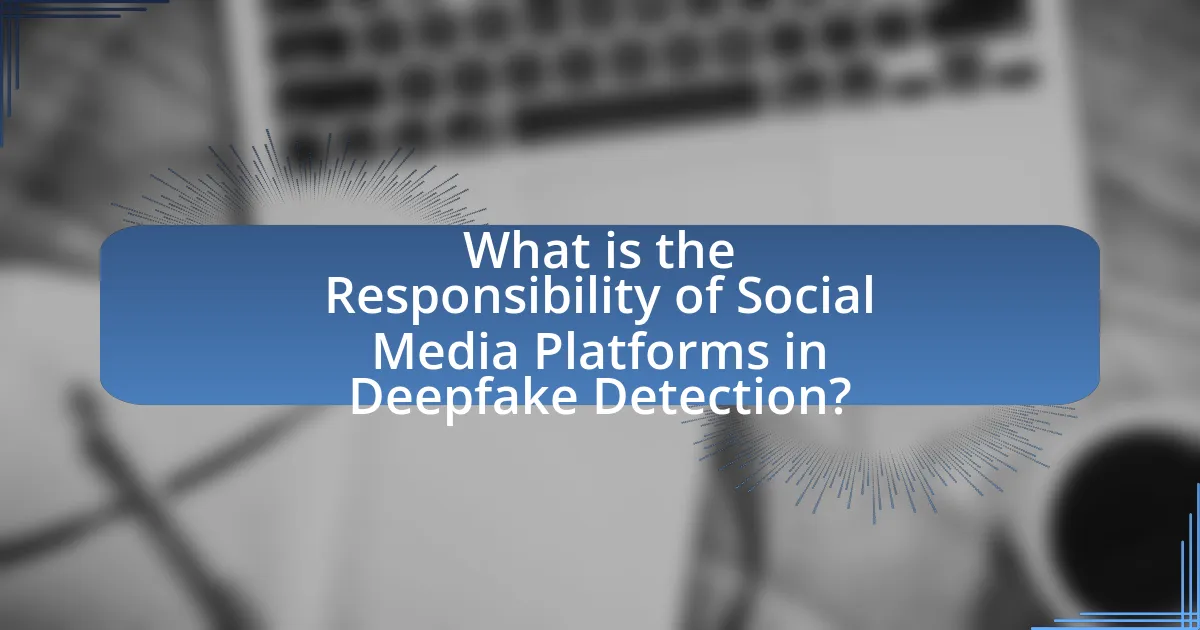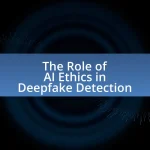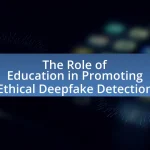The article focuses on the responsibility of social media platforms in detecting deepfakes, emphasizing their role in preventing misinformation and protecting users from harm. It outlines the importance of implementing effective detection technologies, such as AI-driven algorithms, and establishing clear content moderation policies. The article also discusses the potential harms caused by deepfakes, including reputational damage and erosion of trust in media, while highlighting the ethical implications and user privacy concerns associated with detection efforts. Furthermore, it examines current detection methods, challenges faced by platforms, and future trends in deepfake detection, underscoring the need for collaboration and user education to enhance detection capabilities.

What is the Responsibility of Social Media Platforms in Deepfake Detection?
Social media platforms are responsible for implementing effective deepfake detection technologies to prevent the spread of misinformation and protect users from potential harm. This responsibility includes developing algorithms that can identify manipulated media, collaborating with researchers and organizations focused on deepfake detection, and establishing clear policies for content moderation. For instance, platforms like Facebook and Twitter have invested in AI-driven tools to detect deepfakes, reflecting their commitment to addressing this issue. Additionally, the rise of deepfake technology has led to increased scrutiny from regulators, emphasizing the need for social media companies to take proactive measures in safeguarding the integrity of information shared on their platforms.
Why is deepfake detection important for social media platforms?
Deepfake detection is crucial for social media platforms to prevent the spread of misinformation and protect users from manipulation. The proliferation of deepfakes can lead to significant consequences, including the erosion of trust in media, potential harm to individuals’ reputations, and the facilitation of fraud or harassment. According to a report by the Brookings Institution, deepfakes can undermine democratic processes by spreading false information during elections, highlighting the urgent need for effective detection mechanisms. By implementing robust deepfake detection technologies, social media platforms can safeguard their users and maintain the integrity of information shared on their networks.
What are the potential harms caused by deepfakes on social media?
Deepfakes on social media can cause significant harms, including misinformation, reputational damage, and erosion of trust. Misinformation arises when deepfakes are used to create false narratives or manipulate public opinion, as seen in political contexts where fabricated videos can mislead voters. Reputational damage occurs when individuals are depicted in compromising or false scenarios, leading to personal and professional consequences. Additionally, the widespread use of deepfakes can erode public trust in media and information sources, as users may become skeptical of authentic content, contributing to a broader societal issue of distrust in digital communications.
How can deepfakes undermine trust in social media platforms?
Deepfakes can undermine trust in social media platforms by creating misleading and fabricated content that appears authentic. This manipulation of visual and audio media can lead to the spread of false information, eroding users’ confidence in the credibility of the content they encounter. A study by the Massachusetts Institute of Technology found that false information spreads six times faster than true information on social media, highlighting the potential for deepfakes to amplify misinformation. As users become increasingly aware of the prevalence of deepfakes, their skepticism towards all media shared on these platforms may grow, further diminishing trust in the platforms themselves.
What role do social media platforms play in combating deepfakes?
Social media platforms play a crucial role in combating deepfakes by implementing detection technologies and establishing policies to identify and remove misleading content. These platforms utilize artificial intelligence algorithms to analyze videos and images for signs of manipulation, thereby enhancing their ability to flag deepfakes before they spread widely. For instance, Facebook and Twitter have partnered with third-party fact-checkers to review content and provide context, which helps users discern the authenticity of shared media. Additionally, platforms like YouTube have introduced features that alert viewers when a video has been flagged for misinformation, thereby promoting awareness and critical evaluation of content.
How do social media platforms currently detect deepfakes?
Social media platforms currently detect deepfakes using a combination of artificial intelligence algorithms, machine learning techniques, and user reporting systems. These platforms employ deep learning models trained on large datasets of authentic and manipulated media to identify inconsistencies in visual and audio elements, such as unnatural facial movements or mismatched audio-visual synchronization. For instance, Facebook has developed a deepfake detection tool that analyzes videos for signs of manipulation, while Twitter utilizes similar AI technologies to flag potentially deceptive content. Research indicates that these methods can achieve high accuracy rates, with some models reporting over 90% effectiveness in identifying deepfakes.
What technologies are used by platforms for deepfake detection?
Platforms for deepfake detection utilize technologies such as machine learning algorithms, neural networks, and digital forensics techniques. Machine learning algorithms analyze patterns in video and audio data to identify inconsistencies that may indicate manipulation. Neural networks, particularly convolutional neural networks (CNNs), are trained on large datasets of authentic and deepfake content to improve detection accuracy. Digital forensics techniques examine metadata and pixel-level anomalies to uncover signs of tampering. Research has shown that these technologies can achieve high accuracy rates, with some models reporting over 90% effectiveness in distinguishing between real and fake media.
What are the ethical implications of social media platforms’ responsibilities?
Social media platforms have ethical responsibilities to prevent the spread of misinformation and harmful content, particularly in the context of deepfakes. These platforms must implement robust detection systems to identify and mitigate the risks associated with manipulated media, as failure to do so can lead to significant societal harm, including erosion of trust in information sources and potential harm to individuals’ reputations. For instance, a study by the Pew Research Center found that 86% of Americans believe that social media companies should take more responsibility for preventing the spread of false information. This highlights the expectation from users for platforms to actively engage in ethical practices that protect public discourse and individual rights.
How do user privacy concerns intersect with deepfake detection efforts?
User privacy concerns significantly intersect with deepfake detection efforts as the implementation of detection technologies often requires access to personal data. Deepfake detection systems typically analyze user-generated content to identify manipulated media, which raises issues regarding consent and data security. For instance, a study by the University of California, Berkeley, highlights that users may be uncomfortable with platforms utilizing their data for detection purposes without explicit permission, leading to potential violations of privacy rights. Furthermore, the balance between effective detection and user privacy is critical, as overly intrusive measures could deter users from sharing content, ultimately undermining the platforms’ engagement and trust.
What ethical guidelines should social media platforms follow in deepfake detection?
Social media platforms should adhere to ethical guidelines that prioritize transparency, user consent, and accountability in deepfake detection. Transparency involves clearly informing users about the presence of deepfake technology and its implications, ensuring that users can make informed decisions regarding the content they consume. User consent is critical; platforms must obtain explicit permission from individuals before using their likeness in any deepfake content. Accountability requires platforms to implement robust detection systems and take responsibility for the dissemination of misleading or harmful deepfake materials. These guidelines are essential to maintain trust and protect users from potential harm associated with deepfake technology.
How can social media platforms improve their deepfake detection efforts?
Social media platforms can improve their deepfake detection efforts by implementing advanced machine learning algorithms that analyze video and audio content for inconsistencies. These algorithms can be trained on large datasets of known deepfakes, allowing them to recognize patterns and anomalies indicative of manipulation. For instance, a study by the University of California, Berkeley, demonstrated that deep learning models could achieve over 90% accuracy in identifying deepfakes when trained on extensive datasets. Additionally, platforms can collaborate with academic institutions and tech companies to share data and best practices, enhancing the overall effectiveness of detection systems. By investing in research and development, social media platforms can stay ahead of evolving deepfake technologies and protect users from misinformation.
What partnerships can enhance deepfake detection capabilities?
Collaborations between technology companies, academic institutions, and government agencies can significantly enhance deepfake detection capabilities. For instance, partnerships like the one between Facebook and academic researchers have led to the development of advanced algorithms that improve the identification of manipulated media. Additionally, initiatives such as the Deepfake Detection Challenge, supported by various tech firms, foster innovation by encouraging researchers to create more effective detection tools. These collaborations leverage diverse expertise and resources, resulting in more robust solutions against deepfake threats.
How can user education contribute to better deepfake detection?
User education can significantly enhance deepfake detection by equipping individuals with the skills to critically analyze digital content. Educated users are more likely to recognize signs of manipulation, such as inconsistencies in audio-visual synchronization or unnatural facial movements. Research indicates that training programs focused on media literacy can improve detection rates by up to 50%, as users learn to identify red flags associated with deepfakes. Furthermore, informed users can contribute to a collective vigilance, reporting suspicious content and fostering a culture of skepticism towards unverified media. This proactive approach not only aids in immediate detection but also encourages social media platforms to implement more robust verification systems.
What challenges do social media platforms face in deepfake detection?
Social media platforms face significant challenges in deepfake detection due to the rapid advancement of artificial intelligence technologies that create increasingly sophisticated deepfakes. These platforms struggle with the sheer volume of content uploaded daily, making it difficult to monitor and analyze every piece effectively. Additionally, the evolving techniques used by deepfake creators often outpace the detection algorithms, leading to a cat-and-mouse game where detection tools must constantly adapt. Furthermore, the lack of standardized regulations and guidelines for deepfake content complicates enforcement and accountability, as platforms must navigate varying legal frameworks across different jurisdictions.
How does the rapid evolution of deepfake technology complicate detection efforts?
The rapid evolution of deepfake technology complicates detection efforts by continuously improving the realism and sophistication of manipulated media, making it increasingly difficult for existing detection tools to identify them. As deepfake algorithms advance, they can produce videos that closely mimic genuine human expressions and movements, which challenges traditional detection methods that rely on identifying artifacts or inconsistencies. For instance, a study by the University of California, Berkeley, found that state-of-the-art deepfake generation techniques can create videos that are indistinguishable from real footage to the human eye, thereby outpacing the capabilities of many detection algorithms. This ongoing arms race between deepfake creation and detection necessitates constant updates and innovations in detection technology to keep up with the evolving landscape.
What are the limitations of current deepfake detection technologies?
Current deepfake detection technologies face several limitations, including high false-negative rates, reliance on specific types of deepfakes, and the need for extensive training data. High false-negative rates mean that many manipulated videos go undetected, undermining the effectiveness of these technologies. Additionally, many detection systems are optimized for specific types of deepfakes, making them less effective against new or evolving techniques. The requirement for extensive training data also poses a challenge, as obtaining diverse and representative datasets can be difficult, leading to potential biases in detection capabilities. These limitations highlight the ongoing challenges in ensuring reliable deepfake detection.
What best practices should social media platforms adopt for deepfake detection?
Social media platforms should implement advanced machine learning algorithms for deepfake detection. These algorithms can analyze video and audio content for inconsistencies that are characteristic of deepfakes, such as unnatural facial movements or mismatched audio. Research from the University of California, Berkeley, indicates that machine learning models can achieve over 90% accuracy in identifying deepfakes when trained on large datasets. Additionally, platforms should establish a user reporting system that allows users to flag suspicious content, which can then be reviewed by human moderators. This dual approach of technology and community involvement enhances the effectiveness of deepfake detection efforts.
How can transparency in detection processes build user trust?
Transparency in detection processes builds user trust by providing clear insights into how content is analyzed and flagged for authenticity. When users understand the methodologies and technologies employed in detecting deepfakes, they are more likely to feel confident in the platform’s ability to protect them from misinformation. Research indicates that platforms that openly share their detection algorithms and success rates, such as Facebook’s transparency reports, enhance user perception of reliability and accountability. This openness fosters a sense of security among users, as they can see the efforts made to ensure content integrity, ultimately leading to increased trust in the platform.
What measures can be taken to ensure accountability in deepfake detection?
To ensure accountability in deepfake detection, social media platforms must implement robust verification systems and transparent reporting mechanisms. These systems should include advanced AI algorithms capable of identifying deepfakes, alongside human oversight to validate the findings. For instance, platforms like Facebook and Twitter have begun utilizing machine learning technologies to detect manipulated content, which enhances their ability to hold users accountable for sharing false information. Additionally, establishing clear guidelines and penalties for users who disseminate deepfakes can deter malicious behavior. Research indicates that platforms that actively engage in content moderation and provide users with educational resources about deepfakes see a reduction in the spread of misinformation.
What are the future trends in deepfake detection for social media platforms?
Future trends in deepfake detection for social media platforms include the integration of advanced machine learning algorithms, real-time detection capabilities, and collaborative efforts among tech companies. Machine learning algorithms are evolving to improve accuracy in identifying manipulated content, with research indicating that deep learning models can achieve over 90% accuracy in detecting deepfakes. Real-time detection is becoming essential as social media platforms aim to mitigate the rapid spread of misinformation, with tools being developed to analyze videos and images as they are uploaded. Additionally, collaboration among tech companies, researchers, and regulatory bodies is increasing, as seen in initiatives like the Deepfake Detection Challenge, which fosters innovation and standardization in detection methods. These trends highlight a proactive approach to addressing the challenges posed by deepfakes in the digital landscape.
How might advancements in AI impact deepfake detection strategies?
Advancements in AI will significantly enhance deepfake detection strategies by improving the accuracy and speed of identifying manipulated media. Machine learning algorithms, particularly those utilizing neural networks, can analyze vast datasets of authentic and deepfake content, allowing for the development of more sophisticated detection tools. For instance, research has shown that AI models can achieve over 90% accuracy in distinguishing between real and fake videos by examining subtle inconsistencies in facial movements and audio-visual synchronization. As AI technology continues to evolve, these detection systems will likely become more robust, enabling social media platforms to better identify and mitigate the spread of deepfakes, thereby fulfilling their responsibility to maintain the integrity of information shared on their platforms.
What role will legislation play in shaping deepfake detection responsibilities?
Legislation will play a crucial role in defining the responsibilities of social media platforms in deepfake detection by establishing legal frameworks that mandate compliance and accountability. These laws can require platforms to implement specific detection technologies, report deepfake incidents, and take down harmful content, thereby creating a structured approach to managing the risks associated with deepfakes. For instance, the proposed DEEPFAKES Accountability Act in the United States aims to hold platforms liable for failing to detect and remove malicious deepfake content, reinforcing the need for proactive measures in content moderation. This legislative action underscores the importance of regulatory oversight in ensuring that social media companies prioritize user safety and transparency in their operations regarding deepfake technology.
What practical steps can users take to identify deepfakes on social media?
Users can identify deepfakes on social media by closely examining the content for inconsistencies and utilizing verification tools. First, they should look for visual anomalies such as unnatural facial movements, mismatched lip-syncing, or irregular lighting that may indicate manipulation. Additionally, users can check the source of the video or image; reputable accounts are less likely to share deepfakes. Employing reverse image search tools can help verify the authenticity of images, while fact-checking websites can provide context on potentially misleading content. Research indicates that deepfake detection technology is evolving, with tools like Deepware Scanner and Sensity AI available to assist users in identifying manipulated media.


